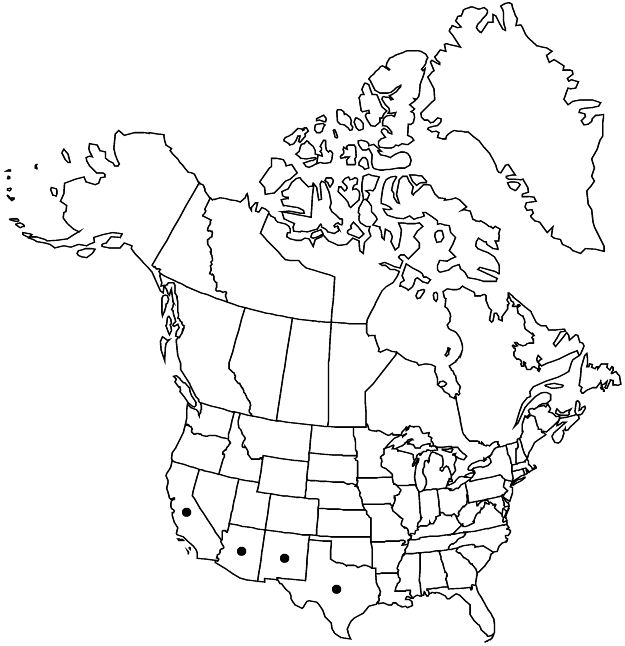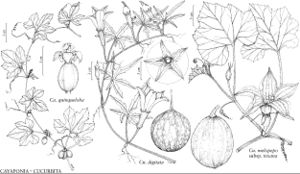Difference between revisions of "Cucurbita digitata"
Smithsonian Contr. Knowl. 5(6): 60. 1853.
FNA>Volume Importer |
FNA>Volume Importer |
||
| Line 53: | Line 53: | ||
|publication year=1853 | |publication year=1853 | ||
|special status=Selected by author to be illustrated | |special status=Selected by author to be illustrated | ||
| − | |source xml=https://jpend@bitbucket.org/aafc-mbb/fna-data-curation.git/src/ | + | |source xml=https://jpend@bitbucket.org/aafc-mbb/fna-data-curation.git/src/f6b125a955440c0872999024f038d74684f65921/coarse_grained_fna_xml/V6/V6_80.xml |
|genus=Cucurbita | |genus=Cucurbita | ||
|species=Cucurbita digitata | |species=Cucurbita digitata | ||
Revision as of 20:17, 24 September 2019
Plants perennial; roots tuberous. Stems usually sprawling, sometimes climbing, often rooting adventitiously at nodes, to 10 m, sparsely hirsute-strigillose with deflexed hairs to hispid-strigose or hirsute-strigose, muriculate or glabrous on ribs; tendrils 2–5-branched 1–1.5 cm above base, glabrous, often gland-tipped. Leaves: petiole 3–4(–8) cm, hispid or hispid and hirsute, often with deflexed hairs; blade depressed-ovate to reniform, palmately 5-lobed, sinuses nearly or completely to petiole, 4–11 × 8–15 cm, usually broader than long, base cordate, lobes narrowly lanceolate to narrowly oblanceolate or oblong-lanceolate, 2–12 cm, margins coarsely toothed or remotely sinuate-dentate to serrate, surfaces hispid to hispidulous, midvein and major veins whitish adaxially, densely hispidulous-strigillose with white hairs, eglandular. Peduncles in fruit shallowly 5-ribbed, not abruptly expanded at point of fruit attachment, spongy. Flowers: hypanthium cylindric to narrowly campanulate, 2.5–3 mm; sepals linear-subulate, 3–5 mm; corolla bright yellow, narrowly campanulate, 4–7 cm; anther filaments glabrous; ovary villous-hirsute. Pepos dark green with 10 whitish stripes and white mottling or yellow at maturity, globose to depressed-globose or oblong-globose, (6–)7–9.5 cm, smooth, rind thin, hard-shelled. Seeds dull white, ovate, obtusely pointed, 8–11 mm, margins thickened-raised, surfaces smooth. 2n = 40.
Phenology: Flowering (Feb, Apr–)May–Sep(–Oct).
Habitat: Larrea desert, often with Acacia, Cercidium, and Yucca, grasslands with Atriplex, mesquite, juniper-scrub, oak savannas (rarely), canal banks, stream bottoms and sides, wash and arroyo banks, dry stream channels, alluvial plains, rocky slopes, disturbed sites, roadsides
Elevation: (100–)300–1500 m
Distribution

Ariz., Calif., N.Mex., Tex., Mexico (Baja California, Chihuahua, Sonora).
Discussion
In Texas, Cucurbita digitata is known by a single collection, from southeastern Presidio County in 1975, along gravelly banks of Fresno Creek (M. L. Butterwick 1980).
Leaves of juvenile plants or the first growth of the season of Cucurbita digitata produce shorter and broader lobes, but mature leaves are similar to those of C. palmata (R. S. Felger 2000). Cucurbita digitata and C. palmata intergrade where their ranges meet in southwestern Arizona, southeastern California, and northeastern Baja California; with C. cordata S. Watson and C. cylindrata L. H. Bailey of Baja California, they form a group of closely related, allopatric, mostly intergrading species (W. P. Bemis and T. W. Whitaker 1965, 1969).
Selected References
None.
